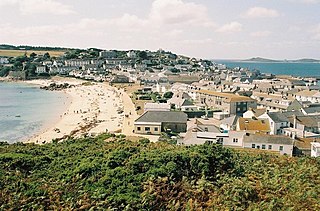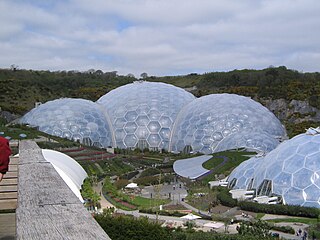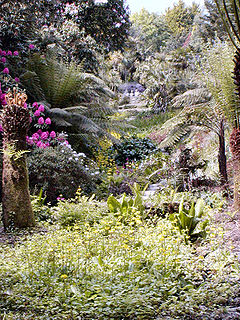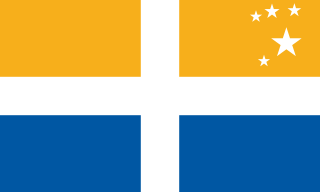
Tresco is the second-biggest island of the Isles of Scilly in Cornwall, England. It is 297 hectares (1.15 sq mi) in size, measuring about 3.5 kilometres (2.2 mi) by 1.75 kilometres (1.09 mi).

St Mary's is the largest and most populous island of the Isles of Scilly, an archipelago off the southwest coast of Cornwall in England.

Hugh Town is the largest settlement on the Isles of Scilly and its administrative centre. The town is situated on the island of St Mary's, the largest and most populous island in the archipelago, and is located on a narrow isthmus which joins the peninsula known as the Garrison with the rest of the island.

Bryher is one of the smaller of the inhabited islands of the Isles of Scilly, with a population of 84 in 2011, spread across 134 hectares (1.34 km2).
Mick Rogers was warden of Portland Bird Observatory and Field Centre at Portland Bill, Dorset, England from 1979 to 1995.

Annet is the second largest of the fifty or so uninhabited Isles of Scilly, 1 kilometre (0.62 mi) west of St Agnes with a length of 1 kilometre (0.62 mi) and approximately 22 hectares in area. The low-lying island is almost divided in two by a narrow neck of land at West Porth which can, at times, be covered by waves. At the northern end of the island are the two granite carns of Annet Head and Carn Irish and three smaller carns known as the Haycocks. The rocky outcrops on the southern side of the island, such as South Carn, are smaller. Annet is a bird sanctuary and the main seabird breeding site in Scilly.

The Isles of Scilly Steamship Company (ISSC) operates the principal shipping service from Penzance, in Cornwall, to the Isles of Scilly, located 28 miles (45 km) to the southwest. It provides a year-round cargo service together with a seasonal passenger service in summer. The name of the company's principal ferry, the Scillonian III, is perhaps better known than that of the company itself.

Land's End Airport, situated near St Just in Penwith, 5 NM west of Penzance, in Cornwall, is the most south westerly airport of mainland Britain. The airport is owned by the Isles of Scilly Steamship Company (ISSC). ISSC's subsidiary Land's End Airport Limited operates the airport, and another subsidiary, Isles of Scilly Skybus, operates a regular passenger service to St Mary's in the Isles of Scilly as well as scenic flights around west Penwith.

Gugh could be described as the sixth inhabited island of the Isles of Scilly, but is usually included with St Agnes with which it is joined by a sandy tombolo known as "The Bar" when exposed at low tide. The island is only about 1 km (0.62 mi) long and about 0.5 km (0.31 mi) wide, with the highest point, Kittern Hill at 34 m (112 ft). The geology consists of Hercynian granite with shallow podzolic soils on the higher ground and deeper sandy soils on the lower ground. The former Gugh farm is just north of the neck across the middle of the island between the two hills. The two houses were designed and built in the 1920s by Charles Hamlet Cooper. The name is often mispronounced as "Goo", "Guff" or even "Gogh".

RMV Scillonian III is a passenger ship based at Penzance in Cornwall, England, United Kingdom, run by the Isles of Scilly Steamship Company. She operates the principal ferry service to the Isles of Scilly and is one of only three ships in the world still carrying the status of Royal Mail Ship.
The Isles of Scilly Wildlife Trust, formed in 1985, is a Wildlife Trust covering the Isles of Scilly, a group of islands off the coast of Cornwall. It became the 46th member of The Wildlife Trusts in 2001 and is dedicated to ensuring that the archaeological and historical remains on the islands, as well as the flora and fauna, are protected and maintained. Since September 2021, the Chief Executive of the trust has been Julian Branscombe.

The Council of the Isles of Scilly is a sui generis unitary local government authority covering the Isles of Scilly off the west coast of Cornwall. It is currently made up of 16 seats, with all councillors being independents. The council was created in 1890 as the Isles of Scilly Rural District Council and was renamed in 1974.
An Island Parish is a British television documentary made by Tiger Aspect Productions for BBC Two. Series 1 and 2 covered the lives of residents of the Church of England parish of the Isles of Scilly. These series were supported by the Diocese of Truro. They followed A Seaside Parish, which covered the work of the Reverend Christine Musser in the parish of Boscastle in Cornwall, and also A Country Parish before that. Series 3 and 4 looked particularly at the work of the Methodist Church on the Isles of Scilly, as seen through the eyes of the local minister, the Revd David Easton. Series 5 moved north and followed Fr John Paul in his first year as the Roman Catholic priest at Castlebay on the island of Barra, the second southernmost inhabited island in the Outer Hebrides. Series 6 was filmed on Barra by Tiger Aspect Productions during 2011 and aired in early 2012, while series seven began in late 2012 and follows the Anglican priest and Methodist minister on Sark. Series 7 and 8 remained on Sark, while Series 9 and 10(2015) focuses on the Falkland Islands. The eleventh series is set in The Shetland Islands, broadcast in March and April 2016. The twelfth series, broadcast from January 2017, focuses on Anguilla.

The economy of Cornwall in South West England, is largely dependent upon agriculture followed by tourism. Cornwall is one of the poorest areas in the United Kingdom with a GVA of 70.9% of the national average in 2015. and is one of four UK areas that qualified for poverty-related grants from the EU. Farming and food processing contributed £366 million to the county, equal to 5.3% of Cornwall’s total GVA. The agricultural/food industry in Cornwall employs 9,500 people, 23,700 are employed in the food industry in Cornwall The Cornish economy also depends heavily on its successful tourist industry which contributes 12% of Cornwall's GDP and supports about 1 in 5 jobs. Tourism contributed £1.85 billion to the Cornish economy in 2011.

Cornwall is the county that forms the tip of the southwestern peninsula of England; this area has a mild and warm climate regulated by the Gulf Stream. The mild climate allows rich plant cover, such as palm trees in the far south and west of the county and in the Isles of Scilly, due to sub-tropical conditions in the summer.

The Isles of Scilly is an archipelago off the southwestern tip of Cornwall, England. One of the islands, St Agnes, is the most southerly point in Britain, being over four miles further south than the most southerly point of the British mainland at Lizard Point.

William Wagstaff, commonly known as Will Wagstaff, is a leading ornithologist and naturalist in the Isles of Scilly, and also an author. His popular guided wildlife walks have made him both a well-known and popular figure in the islands. Originally from South Wales, Wagstaff has lived on the Isles of Scilly since 1981. He has had an active role in conservation work around the islands for more than 20 years, and has led guided wildlife walks there since 1985. He is currently Honorary President and Chairman of the Isles of Scilly Bird Group and regularly presents slideshows and leads other events on the islands. He also writes a regular column A Walk on the Wild Side for the local magazine Scilly Now & Then. He is a Tour Leader for Island Holidays and runs the Island Wildlife Tours group. He is part of the Travelling Naturalist group.
Richard James Vincent Larn, OBE is a retired Chief Petty Officer in the Royal Navy, a businessman and maritime history writer who is widely regarded as one of Britain's leading historic shipwreck experts.

Old Town is a village on St Mary's in the Isles of Scilly located southeast of Hugh Town. It is thought to be the oldest settlement on the island.

The Eastern Isles are a group of twelve small uninhabited islands within the Isles of Scilly Area of Outstanding Natural Beauty, part of the Scilly Heritage Coast and a Site of Special Scientific Interest (SSSI) first designated in 1971 for its flora and fauna. They have a long period of occupation from the Bronze Age with cairns and entrance graves through to Iron Age field systems and a Roman shrine on Nornour. Before the 19th century, the islands were known by their Cornish name, which had also become the name of the largest island in the group after the submergence of the connecting lands.















